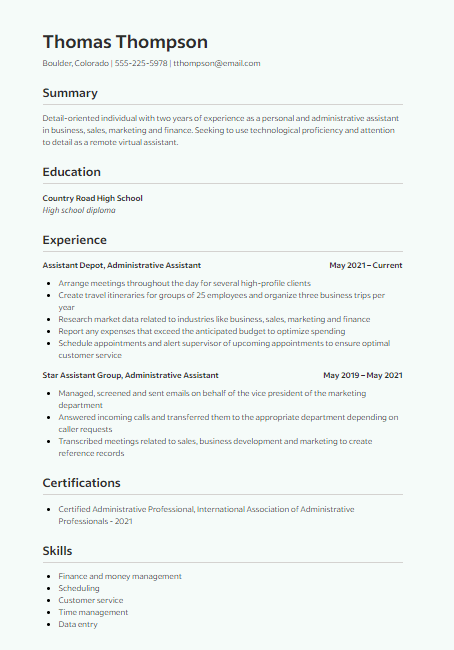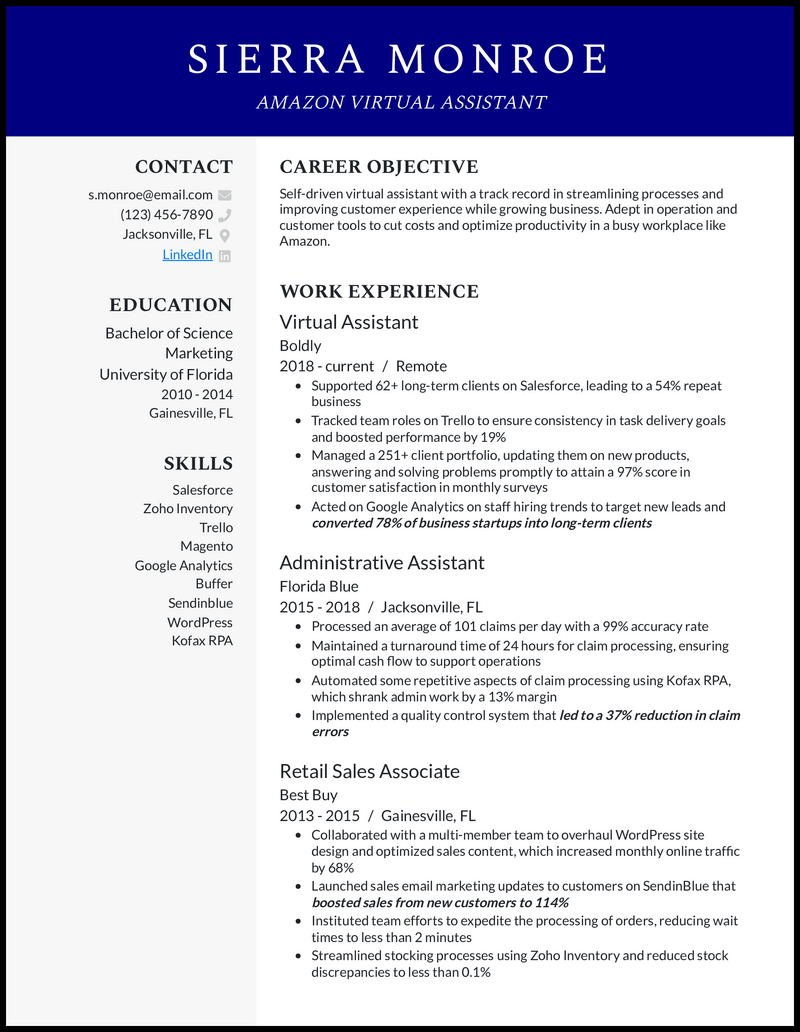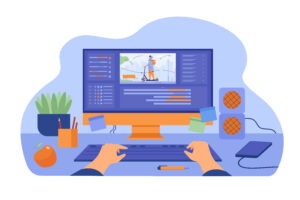
To hire the best help in 2024, you need an updated executive assistant job description. Times are always changing, so we have to stay on top of the trends. This means clarifying role responsibilities, adding skill requirements, and verifying that your offer is an attractive one. In this post, we’ll go over all that plus provide templates. This way, you can see what your executive assistant job description should look like.
What Is the Role of an Executive Assistant?
A good executive assistant job description will have a wide array of skills. They will also have a higher level of proficiency in executing all kinds of admin virtual assistant tasks. Executive assistants have diverse responsibilities and provide crucial services within a business. They function at the executive level. So, what they do and how they do it can actually spell success or failure for the business. Sure, these tasks look simple enough – booking flights and hotel stays, making restaurant reservations for meetings, taking and making phone calls, calendaring appointments, generating reports, managing documents, and the like.
Managing the office of a company executive, however, is not so easy. Mistakes at this level are not as forgivable because this office is the end of the line. No one else is going to come along to check an executive assistant’s work. No one is going to save the day. The tasks themselves are also stricter. Travel arrangements are often within tight schedules. Reservations must be in appropriate settings and with high-level service for important meetings. Phone conversations as a representative of this high office must be executed without room for complaint.
How To Write an Executive Assistant Job Description
The way you write the job description itself is vital. This is what prospective candidates will read first and base their initial interest on. The best ones will be looking for attractive opportunities because they know the value of their work. So, you need to craft the description to carefully include key elements that grab their attention. At the same time, unqualified candidates will hesitate to apply when they read your requirements.
Job Brief
A job brief comes at the top of your description. It defines the reason and purpose for the job. It explains what you want the position to contribute to your company for the next year or so. This description also outlines the tasks that you expect the right candidate to execute and how often. For instance, is it a daily job requiring 8 hours of work, 5 days a week? Finally, the brief must clearly show what it takes to be successful in the job.
You don’t need to be too specific here, because you’ll give more details later. Just say enough to paint an accurate overview of the job. The point is to let the right kind of people know within a minute of reading that it’s a job for them. This is also what you will base your executive assistant interview questions on.
Executive Assistant Responsibilities
An executive assistant provides high-level support to owners or executive officers of a company. They may also extend services to other senior staff members. This section is where you define the types of support and services you require.
Generally, an executive assistant will do clerical and administrative tasks for leadership staff. They might work exclusively for one executive and still liaison with other officers. Sometimes, however, you may want them to take care of other areas. For instance, you might want to task your executive assistant with the HR duty of recruiting and interviewing junior administrative staff for different departments. They are administrative experts, so they will know what to look for and who to hire.
Executive Assistant Skills and Qualifications
An executive assistant must, at the very least, have excellent time management and attention to detail. They need to be highly organized and are often required to be excellent verbal and written communicators. The offices of executives are often the busiest and most fast-paced in any company. So, assistants to these heads must also have the ability to function well in what can be a stressful environment.
As expert administrative personnel, an executive assistant will have proven knowledge of general office administration and clerical procedures. These can include phone etiquette, record-keeping systems, note-taking, office software tools, and the like. Ultimately, it depends on the specific responsibilities and office setup.
Additional Information To Include in the Job Description
If you have any educational requirements or expectations around years or level of experience, include all the details. You might want them to work certain days and times and not on a regular schedule. If the job has physical or other special requirements not mentioned already, list them out. Whatever you need that isn’t explicitly clear, make sure you explain it.
Executive Assistant Job Description Examples
Below are a few examples of executive assistant job descriptions that you can take inspiration from.
Example 1. Executive Assistant to the Chief Executive Officer
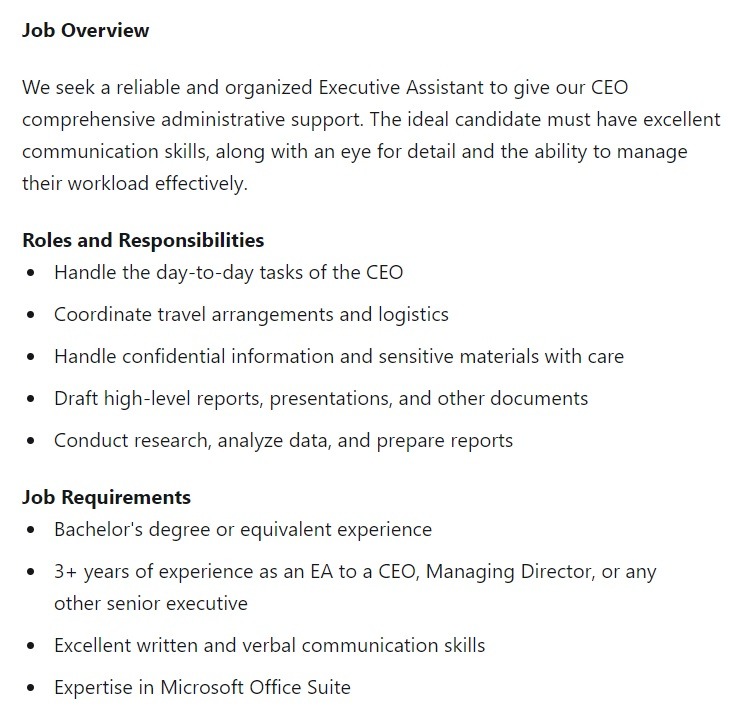
Example 2. Executive Assistant at an Ecommerce Business
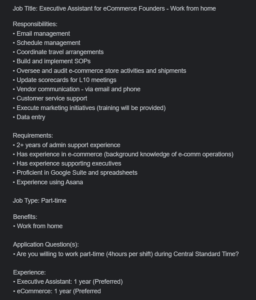
Example 3. Executive Assistant to Chief Marketing Officer at a Large Financial Services Company
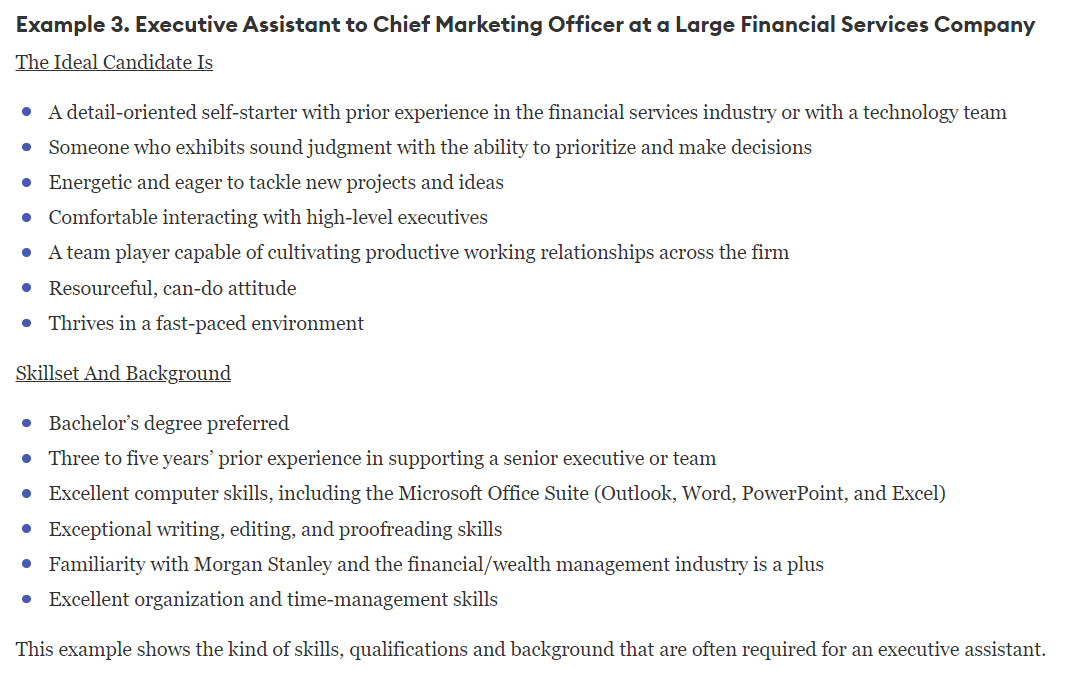
Experience Requirements for an Executive Assistant
Internship Opportunities
You might require specific types of experience. Some of these can only be obtained through special programs or by working similar roles at similar companies. If you can’t find an assistant who has these special skills, you can try hiring an intern. This avenue can cut costs, but might mean that you or one of your managers needs to do training. How extensive that training will be depends on how many special skills you require, and how difficult they are to learn.
By opening up intern-level positions, you will have an easier time finding the right candidate. You can teach them exactly what you want and they will gain the experience in a less demanding environment. This will turn out better for everyone in the long run as the grow into the higher-level position you are targeting.
Most executive-level administrative positions require experience, even if it isn’t special experience. Look into hiring people who have worked as interns in the past. This means that they have a few years under their belts, focused on learning skills despite getting lower pay.
Below are some websites where you can check out options for experience through internships.
Entry-Level Positions vs Experienced Professionals
Entry-level positions do not require experience, but they may require some level of education. Usually, you want administrative assistants to have at least a high school diploma at this level. If you are looking for an executive-level assistant, you should target candidates with a bachelor’s degree. Some exceptions exist, however, and loads of special experience can trump a degree. Either way, make sure you are not preventing otherwise great candidates from applying because your requirements are too strict.
Most executive assistant posts require certain skills, whether it’s an entry-level position or a job for experienced professionals. For instance, any assistant will most likely need to know how to type, use the internet, take notes, and create reports and memos. They should also know the basics of how to book appointments, talk to clients and customers, file reports, set inter-departmental meetings, and the like.
Salary Expectations for Executive Assistants

Factors that Affect Salary Range for this Position
1. Experience
How many years someone has done the work you need will mean a higher rate. Experience equates to efficiency and a generally more valuable contribution to the company. Be prepared to pay more than the average rate if you want quality or special experience. The same goes for requiring many years in previous positions.
2. Industry
Some industries are more complex than others, which means that the work done within them is also more complex. Working as an executive assistant in the advertising and marketing sphere, for instance, is harder than in the eCommerce arena. Working in the smallest biotechnology company, however, would be much harder than in any digital agency. The industry will dictate many details of otherwise common tasks. For example, creating scientific reports can mean understanding nuclear chemistry. A report on monthly sales, on the other hand, entails simple math. The more specialized an assistant’s experience needs to be to excel at the job, the higher you need to pay to find the rare gems who can keep up with you.
3. Location
Hiring from different countries means paying different rate ranges. All other things being equal, this is because of two main factors. First, countries have differing costs of living. Second, a certain hourly rate can buy different amounts of goods in that location. Of course, everything costs different in different countries. The way you can measure an appropriate rate is to look at the costs of thebasics in each country.
All that being said, here’s an example of the differences you can expect in average salaries of executive assistants. These are monthly rates for hires from the US and the Philippines:
- Entry-level: US $4750-5250 vs. Philippines $850-1100
- Mid-level: US $5250-6250 vs. Philippines $1100-1500
- Expert: US $6250-7500 vs. Philippines $1500-2100
What Is Outsource School?

Outsource School helps you to unlock the potential of virtual assistants and accelerate your business growth.
This is the exact system Outsource School’s founders, Nathan Hirsch and Connor Gillivan, used to go from zero to 8 figures and 40+ virtual assistants with an exit in 2019.
Since being founded in 2020, Outsource School has helped 1,000+ business owners hire 2,000+ virtual assistants for their companies.
Schedule a free sales call to learn more
Free resources you might like:
- Outsource School Case Study: How We Scaled to 45+ VAs and 8 Figures in Revenue
- Free VA Calculator | See How Many VAs You Can Afford
- Free Training on 5 Keys to Working With VAs
- Learn Outsourcing 101 | Guides, Downloads, and Checklists
Conclusion
A business owner or manager should never take lightly the task of hiring an executive assistant. Executive assistants perform many vital tasks within a business. This entails that they possess a broad skillset. A good assistant at this level is not easy to find, so it’s up to you to attract the best.












